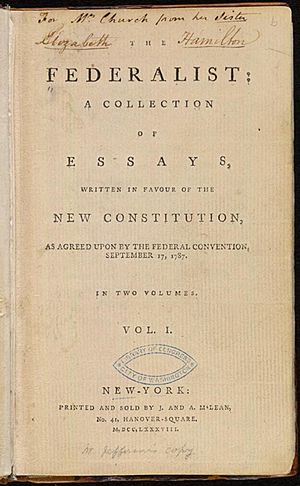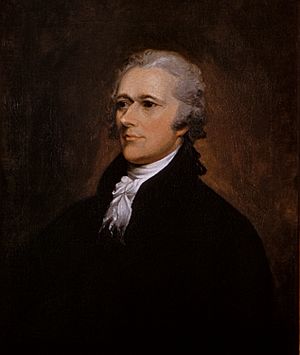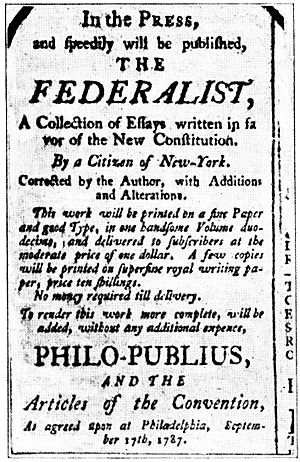The Federalist Papers facts for kids

Title page of the first collection of The Federalist (1788). This particular volume was a gift from Alexander Hamilton's wife Elizabeth Schuyler Hamilton to her sister Angelica
|
|
| Authors | (all under the pseudonym 'Publius') |
|---|---|
| Original title | The Federalist |
| Country | United States |
| Language | English |
| Publisher |
|
|
Publication date
|
October 27, 1787 – May 28, 1788 |
| Media type |
|
The Federalist Papers are a group of 85 articles and essays. They were written by Alexander Hamilton, James Madison, and John Jay. They used the secret name "Publius." Their goal was to convince people to approve the Constitution of the United States. This process is called ratification.
These essays were first printed in New York newspapers. They appeared in the Independent Journal, the New York Packet, and The Daily Advertiser. This happened between October 1787 and April 1788. Later, 77 of these essays, plus eight new ones, were put into two books. These books were called The Federalist: A Collection of Essays, Written in Favour of the New Constitution. They were published in March and May 1788. The last eight papers (Nos. 78–85) were printed in New York newspapers again later in 1788.
The authors of The Federalist wanted to influence voters. They hoped to get them to approve the new Constitution. In Federalist No. 1, they explained their big goal. They asked if people could truly create a good government. Or if they were always stuck with governments made by chance or force.
In Federalist No. 10, Madison talked about how to stop a large group from taking over. This is called "rule by majority faction." He suggested a large republic with lots of business. Federalist No. 14 added to this idea. Madison said the United States was perfect for such a republic. He praised the smart ideas of the people who wrote the Constitution.
Federalist No. 84 was written by Hamilton. He argued that a Bill of Rights was not needed. He believed the Constitution already protected people's freedoms. In Federalist No. 78, Hamilton laid the groundwork for judicial review. This is when courts check if laws follow the Constitution. Federalist No. 70 explained why there should be one strong president. In Federalist No. 39, Madison clearly explained "Federalism." This is about how power is shared between national and state governments.
Federalist No. 51 by Madison talked about checks and balances. This system makes sure no one part of government becomes too powerful. Historian Richard B. Morris called these essays amazing. He said they explain the Constitution better than any other American writing.
On June 21, 1788, enough states approved the Constitution. Nine states were needed, and they reached that number. By late July 1788, eleven states had approved it. Then, the process of setting up the new government began.
Contents
Why Were The Federalist Papers Written?
The Start of the Debate

After the Constitutional Convention, the new Constitution was sent to the states. This was for them to approve it. But not everyone agreed with the new plan. Some people started writing articles against it. These were known as the "Anti-Federalist Papers."
Alexander Hamilton decided to respond to these criticisms. He wanted to explain and defend the proposed Constitution. He wrote in Federalist No. 1 that his essays would answer all the important objections.
Who Wrote Them?
Hamilton asked others to help him. He got John Jay to join. Jay wrote four early essays (Nos. 2, 3, 4, and 5). But then he got sick and only wrote one more, Federalist No. 64. Jay also wrote a separate pamphlet to support the Constitution.
Hamilton also asked James Madison to help. Madison was in New York as a delegate from Virginia. He became Hamilton's main partner in writing. They considered others, but Morris said no, and Hamilton didn't like Duer's essays.
Hamilton chose the secret name "Publius." This name came from Publius Valerius Poplicola. He was a Roman who helped start the ancient Roman republic. His name meant "friend of the people."
Who Wrote Which Papers?
When the essays were first published, the authors kept their identities secret. But smart people soon figured out who Hamilton, Madison, and Jay were.
After Hamilton died in 1804, a list appeared. It said he wrote two-thirds of the essays. But some believed Madison wrote several of them (Nos. 49–58 and 62–63).
Today, experts generally agree on who wrote what:
- Alexander Hamilton wrote 51 articles.
- James Madison wrote 29 articles.
- John Jay wrote 5 articles.
In just six months, these three men wrote 85 articles. Hamilton later became the first secretary of the treasury. Madison, often called the "Father of the Constitution," became the fourth president of the United States. John Jay became the first Chief Justice of the United States.
How Were The Federalist Papers Published?
The Federalist articles first appeared in three New York newspapers. These were The Independent Journal, the New-York Packet, and the Daily Advertiser. They started on October 27, 1787.
The essays were written and published very quickly. Sometimes, three or four new essays by Publius came out in one week. This fast pace made it hard for anyone to argue against them. Hamilton also wanted the essays printed in newspapers outside New York. They were published in other states, but not always regularly. In other places, local writers were sometimes more popular.
Because they were first in New York, most essays started with "To the People of the State of New York."
People wanted to read the essays so much that they were put into books. The first 36 essays were published as a book on March 22, 1788. It was called The Federalist Volume 1. New essays kept appearing in newspapers. A second book volume came out on May 28. It had essays 37–77 and the new ones, 78–85.
In 1792, a French edition finally named the authors. In 1802, an American edition also named them. But Hamilton didn't want each essay to show its author. So, the secret of who wrote what continued for a while.
The first time authors were clearly linked to specific essays was in an 1810 edition. This used a list Hamilton had left. In 1818, Jacob Gideon published a new edition. This one used a list from Madison. The small differences between Hamilton's and Madison's lists caused some debate.
Did The Federalist Papers Change Anything?
The Federalist Papers were written to help get the Constitution approved in New York. But did they actually succeed? It's hard to say for sure.
Each state had its own approval process. The essays weren't always printed in other states. Also, by the time many essays were out, several important states had already approved the Constitution. New York waited until July 26 to approve it.
In New York, The Federalist was important. But other things mattered too. Important people like Hamilton and Jay had a lot of influence. Also, by the time New York voted, ten states had already approved the Constitution. Only nine were needed for it to pass. This put pressure on New York to join. If New York said no, it would be left out.
Only 19 supporters of the Constitution were elected to New York's approval meeting. There were 46 people against it. Even though New York did approve the Constitution, some historians think The Federalist didn't have a huge impact on New Yorkers.
For Virginia, which approved the Constitution on June 25, Hamilton sent the collected essays. They might have been used as a guide for arguments. But George Washington's support and Madison's presence were probably more important.
What Did The Federalist Papers Talk About?
In Federalist No. 1, Hamilton listed six main topics for the essays:
- How the Union (United States) would help the country. (Covered in Nos. 2–14)
- Why the old government (the Articles of Confederation) wasn't strong enough. (Covered in Nos. 15–22)
- Why the new government needed to be strong to keep the Union together. (Covered in Nos. 23–36)
- How the new Constitution fit the ideas of a republican government. (Covered in Nos. 37–84)
- How it was similar to state constitutions. (Covered in No. 85)
- How it would protect freedom and prosperity. (Covered in No. 85)
As they wrote more essays, this plan changed a bit. The fourth topic grew much larger. The last two topics were only briefly mentioned in the final essay.
The essays can also be grouped by who wrote them. At the start, all three authors contributed. But later, long sections were written by just one person. Hamilton wrote Nos. 21–36 and 65–85. Madison wrote Nos. 37–58.
Why They Didn't Want a Bill of Rights
The Federalist Papers are known for being against a United States Bill of Rights. This idea was debated a lot. The Constitution, as first written, didn't list specific rights for people. Instead, it listed the government's powers. It left everything else to the states and the people.
Alexander Hamilton, who wrote Federalist No. 84, worried about a Bill of Rights. He feared that if rights were listed, people might think those were the only rights they had.
However, not everyone agreed with Hamilton. Robert Yates, writing as "Brutus" in the Anti-Federalist Papers, argued the opposite. He said a government without a Bill of Rights could become unfair. The Federalist warned about leaders who might try to gain too much power. The Ninth Amendment later helped clarify this issue.
How Judges Use The Federalist Papers
Judges in the United States often look at The Federalist Papers. They use them to understand what the people who wrote the Constitution intended. This helps them interpret the Constitution today.
For example, they've been used to decide how much power the government has in foreign affairs. They were also used in a case about certain laws in 1798. By the year 2000, The Federalist had been quoted 291 times in Supreme Court decisions.
But there's always been some debate about how much judges should rely on these papers. In 1819, Chief Justice John Marshall said the essays were very important. But he also said judges must decide if their ideas fit new cases. James Madison also said that the Constitution's meaning should come from its own words. If not, it should come from what the people in the states thought when they approved it.
Images for kids
-
James Madison, a key writer of The Federalist Papers, later became the fourth president of the United States.
-
John Jay, who wrote five of The Federalist Papers, became the first chief justice of the United States.
See also
 In Spanish: The Federalist Papers para niños
In Spanish: The Federalist Papers para niños
- Bibliography of the United States Constitution
- American philosophy
- The Anti-Federalist Papers
- The Complete Anti-Federalist
- List of pseudonyms used in the American Constitutional debates




